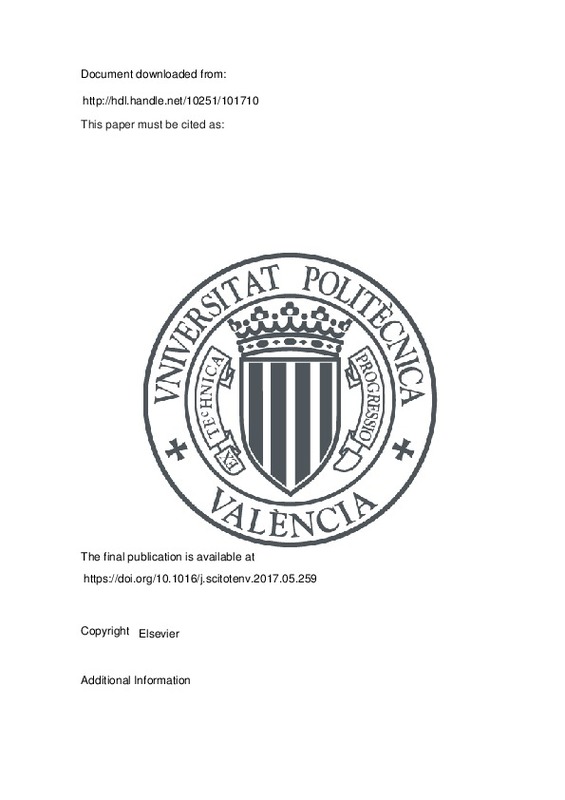Suárez-Almiñana, S.; Pedro Monzonís, M.; Paredes Arquiola, J.; Andreu Álvarez, J.; Solera Solera, A. (2017). Linking Pan-European data to the local scale for decision making for global change and water scarcity within water resources planning and management. The Science of The Total Environment. 603-604:126-139. https://doi.org/10.1016/j.scitotenv.2017.05.259
Por favor, use este identificador para citar o enlazar este ítem: http://hdl.handle.net/10251/101710
|
Título:
|
Linking Pan-European data to the local scale for decision making for global change and water scarcity within water resources planning and management
|
|
Autor:
|
Suárez-Almiñana, Sara
 Pedro Monzonís, María
Pedro Monzonís, María

 Paredes Arquiola, Javier
Paredes Arquiola, Javier

 Andreu Álvarez, Joaquín
Andreu Álvarez, Joaquín

 Solera Solera, Abel
Solera Solera, Abel
|
|
Entidad UPV:
|
Universitat Politècnica de València. Departamento de Ingeniería Hidráulica y Medio Ambiente - Departament d'Enginyeria Hidràulica i Medi Ambient
Universitat Politècnica de València. Instituto Universitario de Ingeniería del Agua y del Medio Ambiente - Institut Universitari d'Enginyeria de l'Aigua i Medi Ambient
|
|
Fecha difusión:
|
|
|
Resumen:
|
[EN] This study focuses on a novel type of methodology which connects Pan-European data to the local scale in the field of water resources management. This methodology is proposed to improve and facilitate the decision ...[+]
[EN] This study focuses on a novel type of methodology which connects Pan-European data to the local scale in the field of water resources management. This methodology is proposed to improve and facilitate the decision making within the planning and management of water resources, taking into account climate change and its expected impacts. Our main point of interest is focused on the assessment of the predictability of extreme events and their possible effects, specifically droughts and water scarcity. Consequently, the Júcar River Basin was selected as the case study, due to the ongoing water scarcity problems and the last drought episodes suffered in the Mediterranean region.
In order to study these possible impacts, we developed a modeling chain divided into four steps, they are: i) data collection, ii) analysis of available data, iii) models calibration and iv) climate impact analysis. Over previous steps, we used climate data from 15 different regional climate models (RCMs) belonging to the three different Representative Concentration Pathways (RCPs) coming from a hydrological model across all of Europe called E-HYPE. The data were bias corrected and used to obtain statistical results of the availability of water resources for the future (horizon 2039) and in form of indicators. This was performed through a hydrological (EVALHID), stochastic (MASHWIN) and risk management (SIMRISK) models, all of which were specifically calibrated for this basin.
The results show that the availability of water resources is much more enthusiastic than in the current situation, indicating the possibility that climate change, which was predicted to occur in the future has already happened in the Júcar River Basin. It seems that the so called Effect 80 , an important decrease in water resources for the last three decades, is not well contemplated in the initial data.
[-]
|
|
Palabras clave:
|
Climate services
,
Júcar River Basin
,
Climate change
,
Pan-European data
,
AQUATOOL DSSS
|
|
Derechos de uso:
|
Reserva de todos los derechos
|
|
Fuente:
|
The Science of The Total Environment. (issn:
0048-9697
)
|
|
DOI:
|
10.1016/j.scitotenv.2017.05.259
|
|
Editorial:
|
Elsevier
|
|
Versión del editor:
|
https://doi.org/10.1016/j.scitotenv.2017.05.259
|
|
Código del Proyecto:
|
info:eu-repo/grantAgreement/EC/Interreg Sudoe/SOE1%2FP5%2FF0026/EU/Développment d'une plateforme de gestion des ressources en eau à l'étiage sur le territoire SUDOE/AGUAMOD/
info:eu-repo/grantAgreement/EC/FP7/308438/EU/Enhancing risk management partnerships for catastrophic natural disasters in Europe/
info:eu-repo/grantAgreement/MINECO//CTM2016-77804-P/ES/ESTIMACION DEL RIESGO AMBIENTAL FRENTE A LAS SEQUIAS Y EL CAMBIO CLIMATICO/
info:eu-repo/grantAgreement/EC/H2020/641811/EU/IMproving PRedictions and management of hydrological EXtremes/
info:eu-repo/grantAgreement/MINECO//CGL2012-34978/ES/NUEVAS TECNICAS PARA LA PLANIFICACION, GESTION Y OPTIMIZACION DE RECURSOS HIDRICOS/
|
|
Agradecimientos:
|
The authors thank the anonymous reviewers for their valuable comments, suggestions and positive feedback. All remaining errors, however, are solely the responsibility of the authors. We would also like to express our ...[+]
The authors thank the anonymous reviewers for their valuable comments, suggestions and positive feedback. All remaining errors, however, are solely the responsibility of the authors. We would also like to express our gratitude to the Jucar River Basin Authority - Confederacion Hidrografica del Jucar (Spanish Ministry of Agriculture, Fishery, Food and Environment) for providing data to develop this study. The authors wish to thank the Spanish Ministry of Economyand Competitiveness for its financial support through the NUTEGES project (CGL2012-34978) and ERAS project (CTM2016-77804-P). We also value the support provided by the European Community's Seventh Framework Program in financing the projects ENHANCE (FP7-ENV-2012, 308438), AGUAMOD (Interreg V-B Sudoe 2016), SWICCA (ECMRWF-Copernicus-FA 2015/C3S_441-LOT1/SMHI) and IMPREX (H2020-WATER-2014-2015, 641811).
[-]
|
|
Tipo:
|
Artículo
|







![[Cerrado]](/themes/UPV/images/candado.png)


